Vol. 70, No. 24 (2021)
2021-12-20
SPECIAL TOPIC—Terahertz biophysics
COVER ARTICLE
SPECIAL TOPIC—Terahertz biophysics
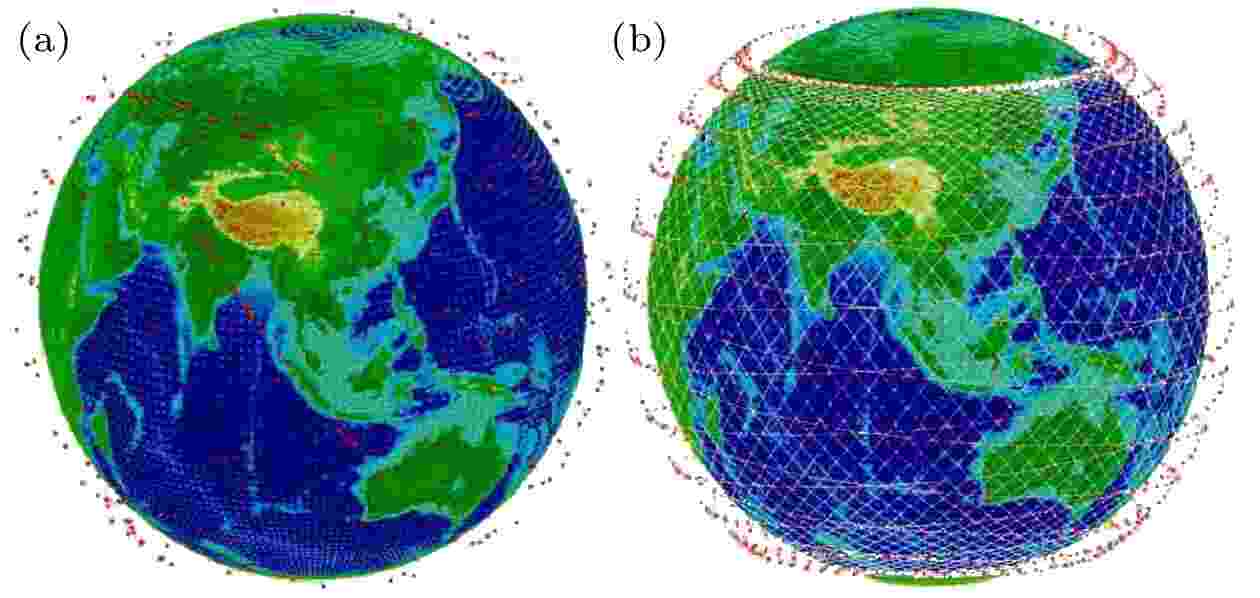
2021, 70 (24): 244303.
doi: 10.7498/aps.70.20211729
Abstract +
The future sixth-generation (6G) wireless network has advantages of global coverage, high spectrum efficiency, low cost, high safety, and higher intelligent level. The 6G technology can create ubiquitous intelligent mobile networks for human society. Terahertz wireless communication has the characteristics of high data transmission rate, low delay, and anti-interference, which may be widely used in 6G technology. This paper mainly introduces the planning vision, development status, and key 6G technology, and analyzes the terahertz devices, channels, communication systems, and the possible development trend of 6G technology.

2021, 70 (24): 247802.
doi: 10.7498/aps.70.20211752
Abstract +
The electromagnetic wave in the terahertz region shows many promising properties, such as non-ionizing, sensitivity to weak resonance, and gradually becomes a basic and applied research hotspot of physics, information, materials, biology, chemistry and other disciplines. However, the analyte molecules tend to be of subwavelength size, and cannot have sufficient interaction with the incident terahertz wave. Small disturbances and subtle features are difficult to detect, which undoubtedly hinders the further development of the terahertz biochemical sensing and detection. The rapid development of terahertz metamaterials provides an alternative method to overcome this obstacle. The intense electromagnetic field enhancement induced by metamaterials allows the sensing and detection application to surpass the limitation of classical terahertz spectroscopy, which is due to the enhancement of the interaction between the analyte and terahertz. In recent years, a series of researches based on terahertz metamaterials combined with new materials, new structures and new mechanisms has offered new opportunities for the application of highly sensitive terahertz biochemical sensing and detection. In this paper, the recent advances in the application of terahertz metamaterials biochemical sensing are reviewed. The related concepts are briefly introduced and the influences of different factors on the sensing performance of metamaterial sensor are analyzed. According to the material selection and design strategies, the related researches of terahertz metamaterial biochemical sensing and detection are summarized. Furthermore, the novel strategy of terahertz metamaterial sensing and detection application based on multidisciplinary are presented, and the future development directions are also discussed, which will greatly conduce to expanding the practicality of terahertz sensing and detection.

2021, 70 (24): 248707.
doi: 10.7498/aps.70.20212030
Abstract +
Irradiation of terahertz electromagnetic wave including its short-wave band in infrared wave shows broad and important application prospects in biological science due to its noninvasive and nonionizing nature. Cell membrane is an important biological barrier for keeping cell integrity and homeostasis, and it is also the cellular structure that electromagnetic fields act first on in the case of terahertz irradiation. The responses of cell membrane to the electromagnetic fields are the mechanisms for most of the biological effects of terahertz irradiation. First, in this paper are expatiated the application safety of terahertz irradiation and its new application prospects in life medicine, neural regulation and artificial intelligence. Then, systematically described are the researches and developments in the biological effects of cell membrane under terahertz electromagnetic irradiation from the following four aspects: the dielectric response characteristics of phospholipid membrane to terahertz electromagnetic irradiation, the transmembrane transport of ions through membrane ion channel proteins under the irradiation, the transmembrane transport of macromolecules and ions through phospholipid membrane under the irradiation, and the potential applications and role of biological effects of cell membrane under the irradiation. Meanwhile, introduced in this paper are the scientific discoveries that terahertz electromagnetic irradiation is able to activate voltage-gated calcium channels, voltage-gated potassium channels and active transport calcium channels in cell membrane and to create hydrophilic pores on the phospholipid membrane of cell membrane. Finally, the directions of future efforts to study the biological effects of cell membrane under terahertz irradiation are presented.

2021, 70 (24): 240701.
doi: 10.7498/aps.70.20211996
Abstract +

2021, 70 (24): 240301.
doi: 10.7498/aps.70.20211677
Abstract +
The size of nerve cell is comparable to the wavelength of terahertz (THz) wave. In this work, a new concept of weak resonance effect of nerve cells is proposed. The permittivity of intracellular fluid is measured experimentally by using a THz-TDS system, and the relationship between the permittivity of nerve cells and the frequency is obtained by fitting the double Debye model. The propagation characteristics of THz waves in nerve cells are studied by finite difference time domain. The results show that when the dielectric constant of nerve cell is higher than that of the external medium, THz wave can be enhanced in the nerve cell. Meanwhile, as the dielectric constant of the external medium increases, the resonance will be close to the cell membrane. And it shows the focusing property of THz waves, as a convex lens does. The weak resonance effect is related to the dielectric constant of the background medium, and increases with the cell size and frequency increasing. These results provide a new model to explain the interaction between THz wave and nerve cells, contributing to the study of the transmission mechanism of THz wave in biological nervous system.

2021, 70 (24): 243101.
doi: 10.7498/aps.70.20211482
Abstract +
The physical properties and dynamics of molecules can be studied by the interaction between electromagnetic field and molecular system. The continuous development of terahertz technology provides a terahertz source capable of generating a sub-picosecond directional intense electric field. The generated intense-field terahertz wave has the same electric field intensity as the molecular local electric field environment, and on a sub-picosecond time scale of the directional electric field there can happen many ultrafast physical and chemical reactions. At present, the interaction between terahertz waves and molecules is limited mainly to the resonance interaction, that is, the molecules transition at different vibrational levels, caused through dipole interaction. In this work, based on the density functional theory calculation and the finite difference time domain solution method of Schrödinger equation, the intense non-resonance effect of intense terahertz wave electric field on hydrogen molecules is studied. The results show that under the action of intense terahertz wave sub-picosecond directional intense electric field, hydrogen molecule will produce an induced dipole moment. This dipole interacts with the external terahertz field, resulting in the fluctuation of proton probability density distribution and the change of vibration energy level population. Based on the non-resonant interaction between non-polar diatomic molecule hydrogen and intense terahertz wave, a unique way of producing the interaction between electromagnetic waves and molecules is displayed in this work, which is a method of studying the dynamics of non-polar molecules and molecules with weak polarity in intense terahertz field.
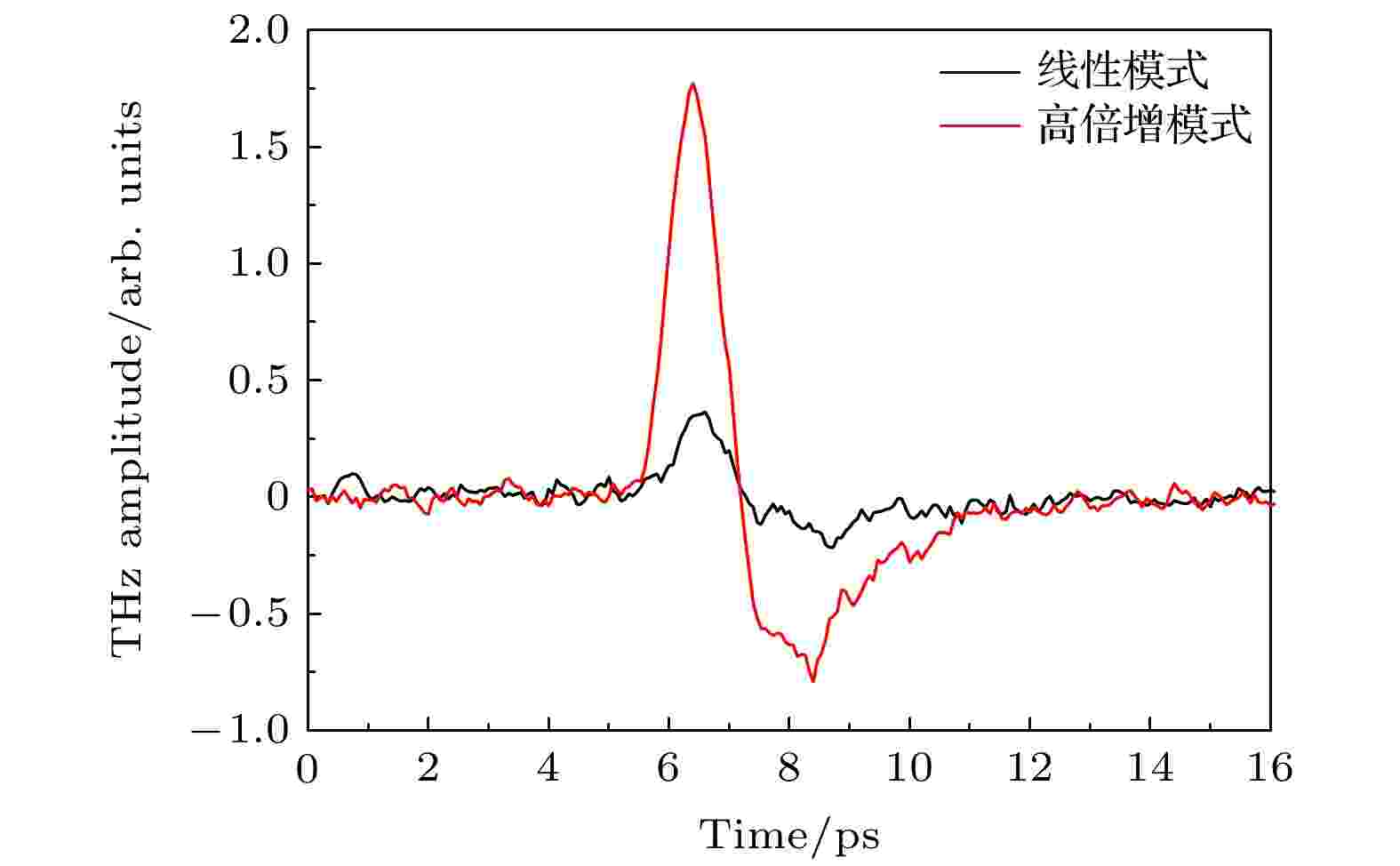
2021, 70 (24): 243202.
doi: 10.7498/aps.70.20211716
Abstract +
Water has the strong absorption of terahertz (THz) wave, so it always a difficult problem to study the characteristics of aqueous samples by THz technology. In this paper, THz waves with high field strength are obtained at the position of sample by using photoconductive antenna working in high-gain mode and horn shaped graded parallel plate waveguide in THz time-domain spectrum system, and the THz spectrum of α-lactose solution in a range of 0.1-1.5 THz is directly detected. Furthermore, the absorption spectrum of α-lactose single molecule model in water environment is simulated by the density functional theory, and the simulation results are in good agreement with the experimental results. This work has important reference value for directly detecting the spectral characteristics of water samples in THz band.

2021, 70 (24): 248701.
doi: 10.7498/aps.70.20211725
Abstract +
Potassium channels play an important role in repolarizing the nerve cell action potentials. There are many types of potassium channel proteins, and potassium channels allow potassium ions to specifically pass through the cell membrane, thereby maintaining the resting potential of nerve cells. In this paper, molecular dynamics simulation method is used to simulate the effects of 53.7 THz terahertz wave with different amplitudes on the secondary structure of KcsA potassium channel protein and the potassium ions rate. It is found in this study that under the action of the 53.7 THz terahertz wave, the number of alpha helices in KcsA potassium channel protein decreases, and the number of beta sheets and the number of coils increase. In addition, the 53.7 THz terahertz wave can accelerate potassium ions through the KcsA potassium channel. In this article, the effects of terahertz waves on potassium channel proteins are analyzed through the secondary structure of proteins, and a new perspective for the interaction between terahertz waves and biological functional molecules is presented as well.
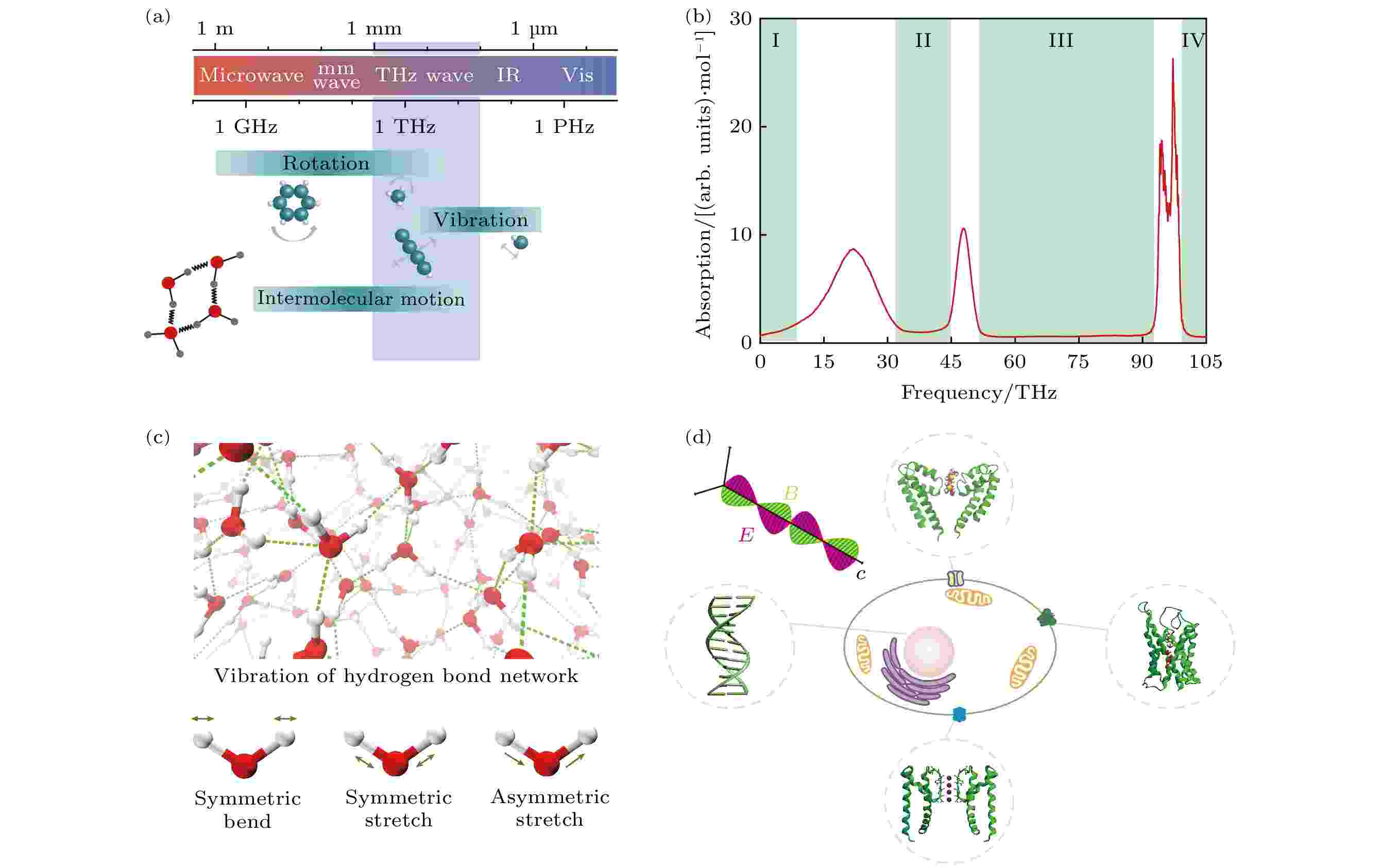
2021, 70 (24): 248702.
doi: 10.7498/aps.70.20211731
Abstract +
Water is the source of all life. The understanding of the terahertz absorption spectrum of water is the prerequisite for the application of terahertz technology to biomedicine. The choice of terahertz frequency is essential for achieving the biological effects of terahertz with high efficiency and low energy consumption. The complex hydrogen bond network of water possesses a broad terahertz absorption peak. Therefore, it is necessary to study the relation between the dynamics of the hydrogen bond network of water and its terahertz absorption spectrum. However, the research in this field is still lacking. Using molecular dynamics simulation methods, the terahertz absorption spectra of different water models at room temperature and pressure are studied in this work. Furthermore, taking the temperature as a variable, the dependence of the terahertz absorption spectrum of water on the strength of the hydrogen bond network is explored. It is found that rising temperature makes the terahertz absorption spectrum of the hydrogen bond network red-shift, indicating that the center frequency of the spectrum is strongly correlated with the strength of the hydrogen bond. Further studies show that there is a linear relationship between the hydrogen bond lifetime of water and the center frequency of vibration absorption peak of the hydrogen bond network. The underlying mechanism can be disclosed by imitating the hydrogen bonds in the hydrogen bond network as springs then using the spring oscillator model. These findings are conducive to understanding in depth the complex hydrogen bond network dynamics in water and promoting the study of terahertz biological effects.

2021, 70 (24): 248703.
doi: 10.7498/aps.70.20211715
Abstract +
Terahertz scattering scanning near-field optical microscopy (s-SNOM), as an important means to break through the limits of conventional optical diffraction, can achieve super-resolution imaging on a nanoscale and has a wide range of applications in biological nano-imaging, terahertz nano-spectroscopy, nanomaterials imaging, and the study of polarized excitations. As an important component of the terahertz s-SNOM, the atomic force microscope tip plays a key role in implementing the near-field excitation, detection, and enhancement. However, the tip-sample interaction can greatly affect the results. In this paper, the effects of tip-sample interaction on near-field excitation, near-field detection, and terahertz near-field spectrum in terahertz s-SNOM are revealed through simulations and experiments. First, the wave vector coupling weight of the near field excited by the tip is investigated, and it is found that the wave vector is concentrated mainly on the order of 105 cm–1, which differs from that of the general terahertz excitations by 2 to 3 orders of magnitude, indicating that the terahertz near field is difficult to excite terahertz excitations. Secondly, through theoretical and experimental studies, it is found that the metal tip interferes with the surface near-field of the graphene disk structure, which indicates the limitations of the terahertz s-SNOM in probing the near-field distribution of the structure. Finally, the influence of the tip on the near-field spectrum is studied. It is found that the tip length and cantilever length are important parameters affecting the near-field spectrum, and the influence of the tip on the near-field spectrum can be reduced by increasing the tip length or cantilever length.

COVER ARTICLE
2021, 70 (24): 248704.
doi: 10.7498/aps.70.20211210
Abstract +
A GaAs photoconductive antenna is one of the important radiation sources of terahertz electromagnetic waves. Antenna arrays can increase the radiation intensity of terahertz waves. Therefore, photoconductive antennas and arrays have attracted much attention for a long time. In this study, CST Microwave Studio is used to conduct a simulation calculation of the characteristics of a photoconductive antenna array radiating terahertz electromagnetic waves. Using the current transient model, the pulsed photocurrents generated when the laser is incident on the GaAs photoconductive antenna are calculated. With the pulsed photocurrents serving as an excitation source, a simulation calculation of the radiation performance of photoconductive antenna is conducted, and the effects of antenna structure and substrate material on the radiation of terahertz waves are analyzed. Based on this, the far-field radiation of terahertz wave radiated by the GaAs photoconductive antenna array is calculated. The simulation results show that the photoconductive antenna array radiates terahertz waves with stronger directivity. The width of main lobe is reduced, and its far-field radiation conforms to the multiple relationships of electric field superposition. A 1 × 2 GaAs photoconductive antenna array is developed, and the experimental results are consistent with the simulation conclusions, thereby laying a theoretical and experimental basis for fabricating the multielement terahertz photoconductive antenna arrays.

2021, 70 (24): 248705.
doi: 10.7498/aps.70.20211779
Abstract +
Methane hydrate (so-called flammable ice) has many advantages such as wide distribution, large resource reserves, high energy density, being clean and pollution-free, etc. Thus, it has attracted much attention since it was discovered. Unfortunately, its exploration encounters many difficulties, which involve mainly with the dissolution process of caged methane hydrate. Therefore, in this work the specific effect of THz electromagnetic wave on decomposition of the hydrate is explored through molecular dynamics simulations. Analyzing the vibrational spectrum of the hydrogen-bond network in methane hydrate, no specific absorption peak is found in the bulk water. Applying a THz wave at this specific frequency to the methane hydrate, the original hydrogen-bond network is broken, the coordinate number of water molecules for the methane decreases, and ultimately the methane frees from the water cage. The F4 ordered parameters further validate the phase change from the crystal water to liquid water under the same THz field irritation. It is also proved that this peak absorption frequency has a remarkable superiority over other frequencies in decomposing the methane hydrate, hence it has specificity. Our findings support the feasibility of non-thermally dissolving methane hydrate, which promises to promote the exploitation efficiency and development of new energy sources in the future.

2021, 70 (24): 248706.
doi: 10.7498/aps.70.20211807
Abstract +
GENERAL
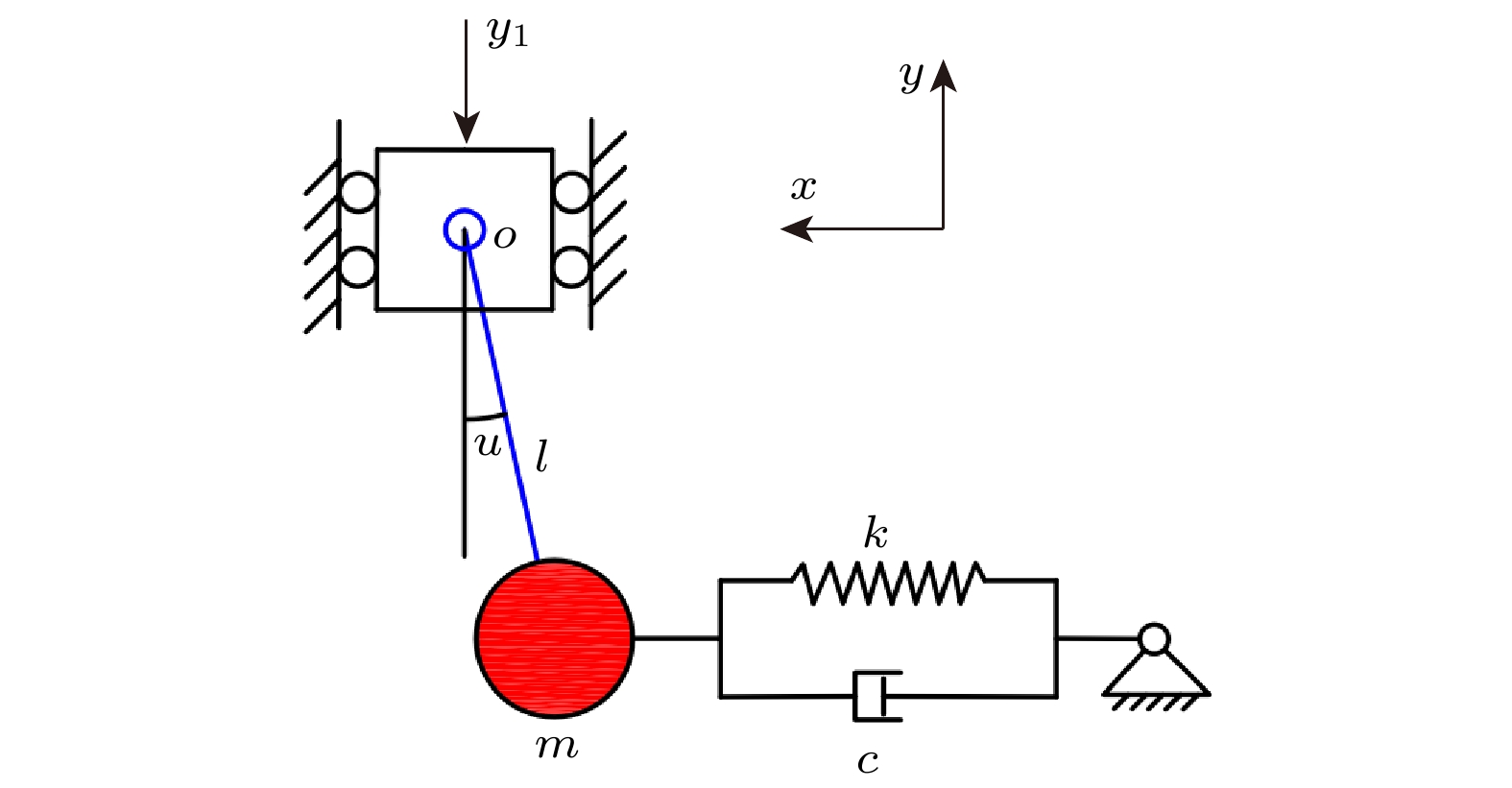
2021, 70 (24): 240202.
doi: 10.7498/aps.70.20210953
Abstract +
In order to improve the working performance and optimize the working parameters of the typical engineering pendulum of a typical system that it is abstracted as a physical simple pendulum model with vertical excitation and horizontal constraint. The dynamical equation of the system with vertical excitation and horizontal constraint is established by using Lagrange equation. The multiple-scale method is used to analyze the subharmonic response characteristics of the system. The amplitude-frequency response equation and the phase-frequency response equation are obtained through calculation. The effects of the system parameters on the amplitude resonance bandwidth and variability are clarified. According to the singularity theory and the universal unfolding theory, the bifurcation topology structure of the subharmonic resonance of the system is obtained. The Melnikov function is applied to the study of the critical conditions for the chaotic motion of the system. The parameter equation of homoclinic orbit motion is obtained through calculation. The threshold conditions of chaos in the sense of Smale are analyzed by solving the Melnikov function of the homoclinic motion orbit. The dynamic characteristics of the system, including single-parameter bifurcation, maximum Lyapunov exponent, bi-parameter bifurcation, and manifold transition in the attraction basin, are analyzed numerically. The results show that the main path of the system entering into the chaos is an almost period doubling bifurcation. Complex dynamical behaviors such as periodic motion, period doubling bifurcation and chaos are found. The bi-parameter matching areas of the subharmonic resonance bifurcation and chaos of the system are clarified. The results reveal the global characteristics of the system with vertical excitation and horizontal constraint, such as subharmonic resonance bifurcation, periodic attractor multiplication, and the coexistence of periodic and chaotic attractors. The results further clarify the mechanism of the influence of system parameters change on the movement form transformation, energy distribution and evolution law of the system. The mechanism of the influence of relevant parameters on the performance of the engineering system with vertical excitation and horizontal constraint is also obtained. The results of this research provide theoretical bases for adjusting the parameters of working performances of this typical physical system in engineering domain and the vibration reduction and suppression of the system in actual working conditions.
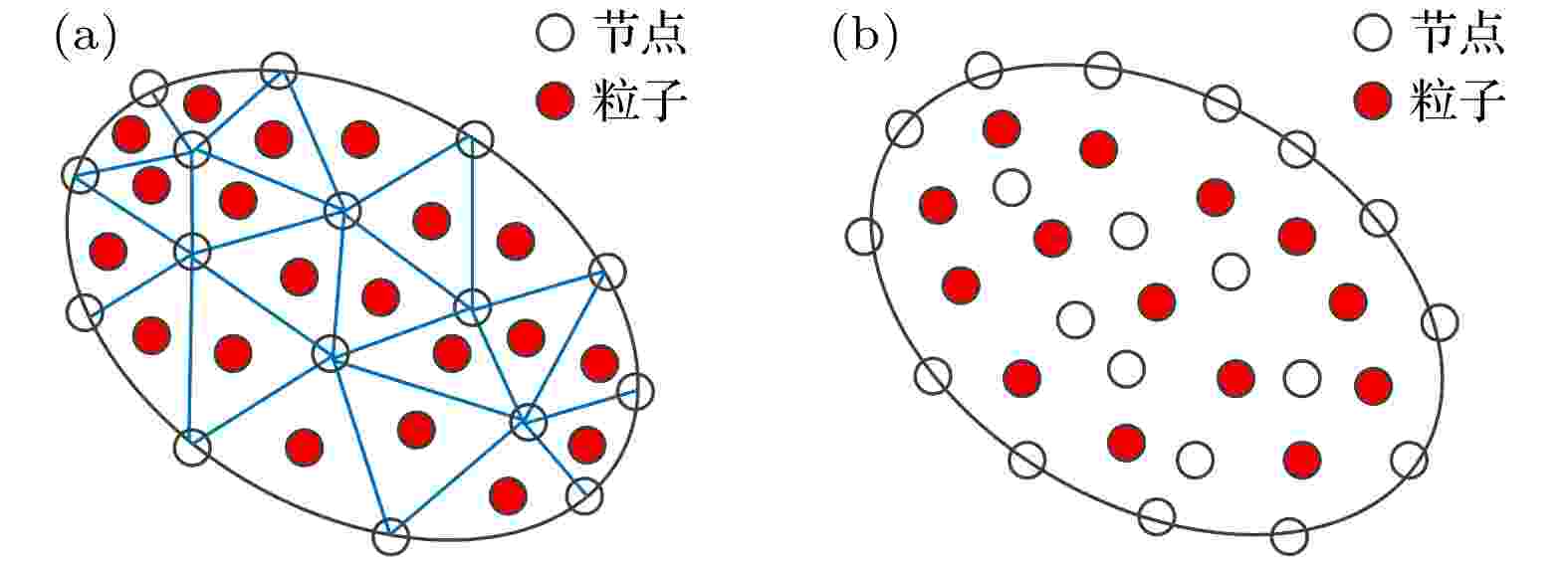
2021, 70 (24): 240203.
doi: 10.7498/aps.70.20211078
Abstract +
Owing to challenges encountered by mesh-based CFD methods when simulating large material deformation, a number of meshfree methods have been presented. The optimized transportation meshfree method is a newly developed meshfree method, but it inherits the advantage of the finite element method in boundary treatment and thus having great potential applications in surface tension effect simulation. By adding the surface tension potential into the Lagrangian, the resulting generalized force acts on fluid surfaces exactly. The axial symmetry treatment is also discussed. By simulating several benchmark cases such as two- and three-dimensional Poiseuille flow, static and vibrating drop and drop deformation, the advantages like precision and convergence of the optimized transportation meshfree method in simulating surface tension effect are verified.

EDITOR'S SUGGESTION
2021, 70 (24): 240302.
doi: 10.7498/aps.70.20210796
Abstract +
An appropriate weak value can be used to amplify weak physical parameters and improve the precision of parameter estimation in the process of quantum weak measurement. The increase of the precision of such a parameter estimation may originate from the entanglement in the system. This paper uses Fisher information to study the influence of the entanglement in the system and the entanglement between the system and the pointer on the estimation precision of the coupling parameters between the system and the pointer in the process of weak measurement. The entanglement of the entangled pure state of the GHZ-like state and the entangled mixed state affected by the depolarization noise and the influence of the entanglement between the system and the pointer on the parameter estimation are analyzed. The results show that the Fisher information quantity increases with the increase of the initial state entanglement degree of the system when the initial state of the system is an entangled pure state or an entangled mixed state affected by depolarization noise, and both the Fisher information quantity and the post-selection probability reach their maximum values when the initial and final state of the system are both the maximum entangled states; but the weaker the entanglement between the system and the pointer, the more the Fisher information obtained in the measurement will be and the higher the accuracy of parameter estimation. These research results show that the entanglement in the system will improve the precision of parameter estimation, while the entanglement between the system and the pointer will reduce the precision of parameter estimation.

2021, 70 (24): 240303.
doi: 10.7498/aps.70.20211216
Abstract +
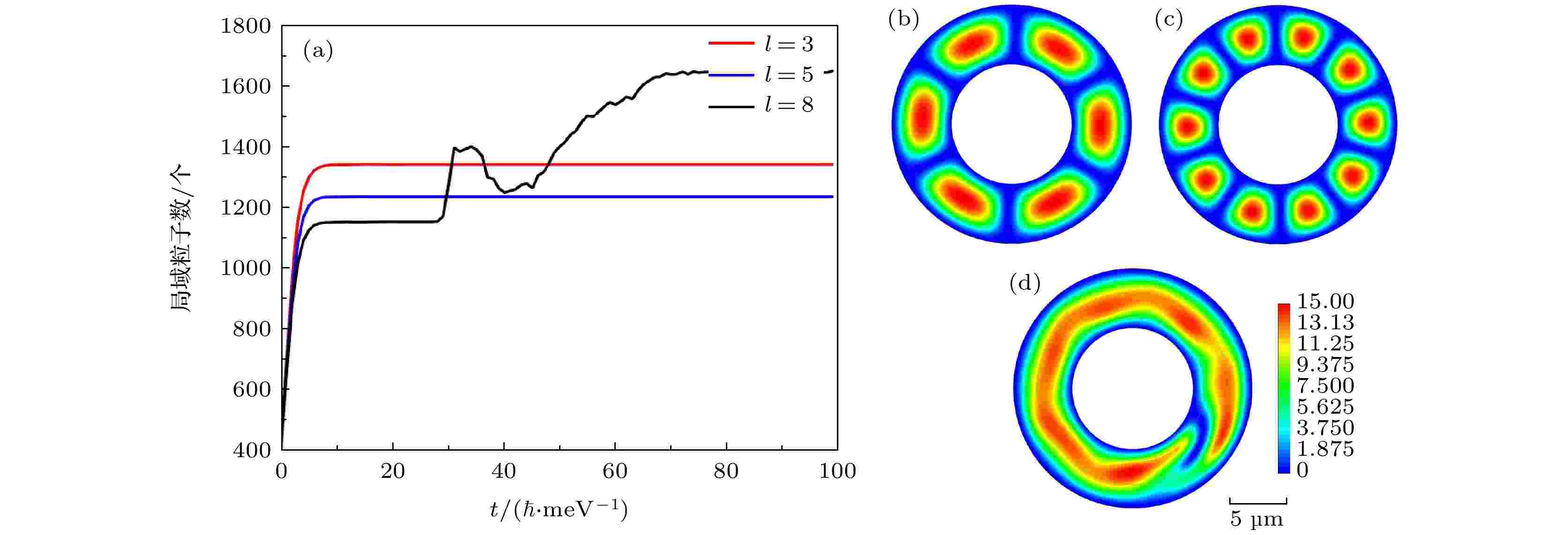
2021, 70 (24): 240304.
doi: 10.7498/aps.70.20210971
Abstract +
Owing to its light effective mass, polariton can easily realize Bose-Einstein condensates (BEC) and can also produce gyro effect under external drive. Therefore, it has a promising application prospect. Based on the Gross-Pitaevskii equation, the evolution of the exciton polaron BEC system in the annular microcavity is studied. Two key parameters affecting the characteristics of the exciton polaron system, namely the size of the microcavity and the configuration of the ring-shaped pumped beam, are investigated. The size of microcavity often directly affects the volume and power consumption of integrated devices. In addition, the number of coherent petals of exciton polariton superposition state matter wave propagated in microcavity is closely related to the precision and sensitivity of gyro, and the size of microcavity has a direct effect on the number of coherent petals. At the same time, whether the pumping region is continuous or not also has a key effect on the evolution of the system, and different pump configurations will affect the evolutions of the system. We find that in the microcavity radius on a micron scale, the annular microcavity can excite the petal of vortex superposition state when pumped by pumping light, and the petals can be stable, but circular cavity with a certain radius can “accommodate” a limited vortex quantum number, when vortex quantum number is too large, the system will be unstable and unable to support the formation of stable petals. However, with the increase of the radius of the annular microcavity, the superposition petal number of the exciton polariton system contained in the annular region will also increase, and the maximum petal number contained in the exciton polariton system has a positive linear correlation with the inner radius of the annular microcavity. At the same time, we find that when the pump laser configuration is changed, the system will evolve into a special form of steady state. The calculation results show that when microcavity parameters are the same but for only changing the radial width of single pump, the number of petals obtained is three times that before changing the radial width. In such a case, the number of superposition petals not only exceeds the previously calculated maximum number of petals accommodated by the annular cavity under the radius but also there appear the multiple petals combined radially. Under the double-ring pump system, changing the width of the hollow ring may produce not only the new exciton polariton condensation in the hollow ring, but also vortex states in the original petal. Under each of the three-ring and four-ring pumping condition, the evolution of the system finally presents a multi-petal state in the radial direction. Because these vortex superposition states contain the information about the density and the phase, it has important guiding significance for designing the new system of gyroscope. Therefore, these special evolutionary results open a new direction for studying the new system gyroscope.

2021, 70 (24): 240501.
doi: 10.7498/aps.70.20210492
Abstract +
Lyapunov exponent is a significant symbol to identify the nonlinear dynamic characteristics of the system. However, most of algorithms are not universal enough and complex. According to the classic Lyapunov exponent algorithm and perturbation theory, in this paper we propose a new algorithm which can be used to compute Lyapunov exponents for discontinuous systems. Firstly, the initial value of the system state parameter and the disturbance of each basic vector along the phase space are taken as initial conditions to determine the phase trajectory. Secondly, the method of difference quotient approximate derivative is adopted to obtain the Jacobi matrix. Thirdly, the eigenvalues of the Jacobi matrix are calculated to obtain the Lyapunov exponent spectrum of the system. Finally, the algorithm in a two-degree-of-freedom system with impacts and friction is used, showing its effectiveness and correctness by comparing its results with the counterparts from the synchronization method. The algorithm can not only be used for discrete systems and continuous-time dynamic systems, but also quickly calculate the Lyapunov exponent of complex discontinuous systems, which provides a new idea for determining the dynamic behavior of complex discontinuous systems.
NUCLEAR PHYSICS
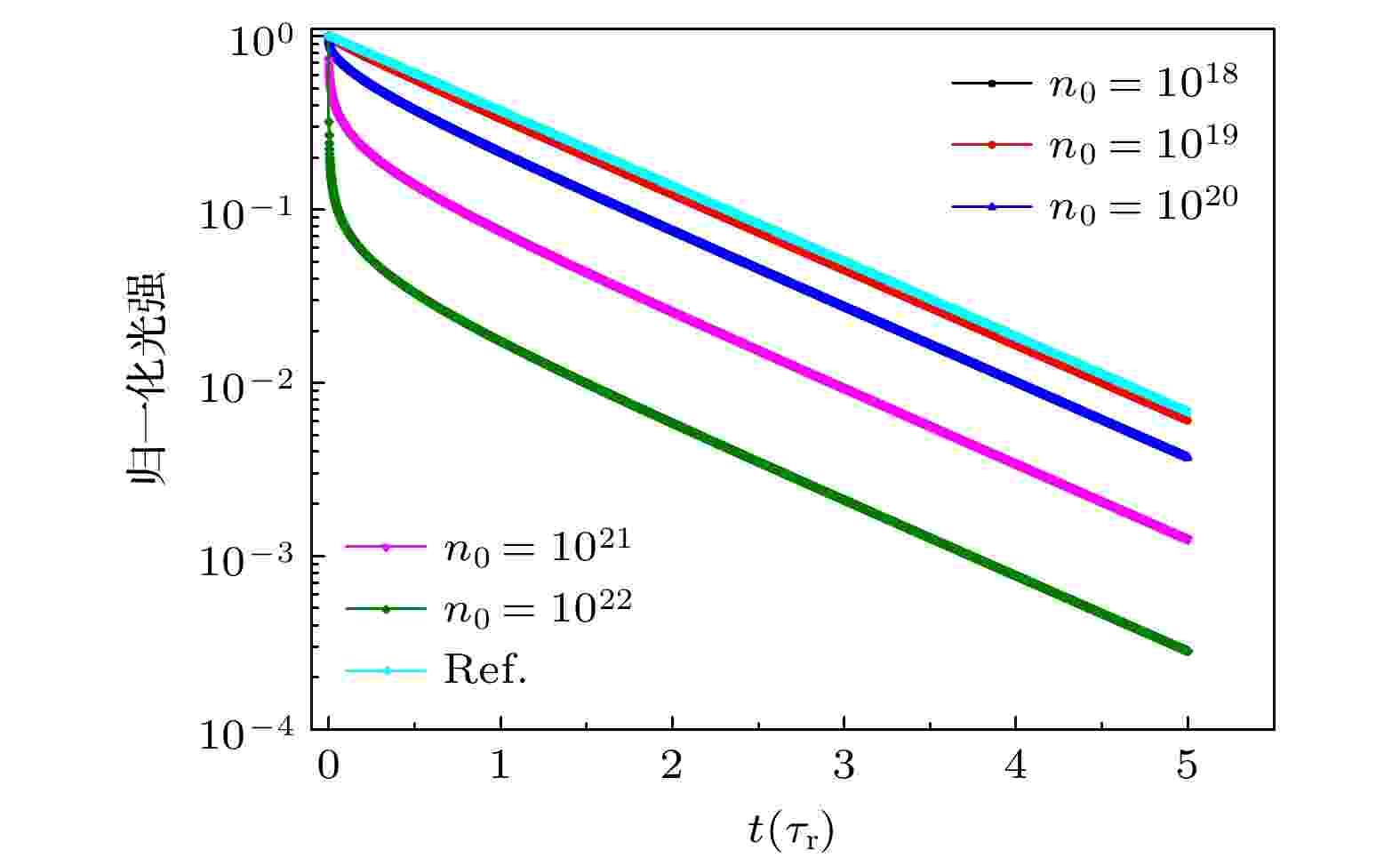
EDITOR'S SUGGESTION
2021, 70 (24): 242901.
doi: 10.7498/aps.70.20210820
Abstract +
ATOMIC AND MOLECULAR PHYSICS
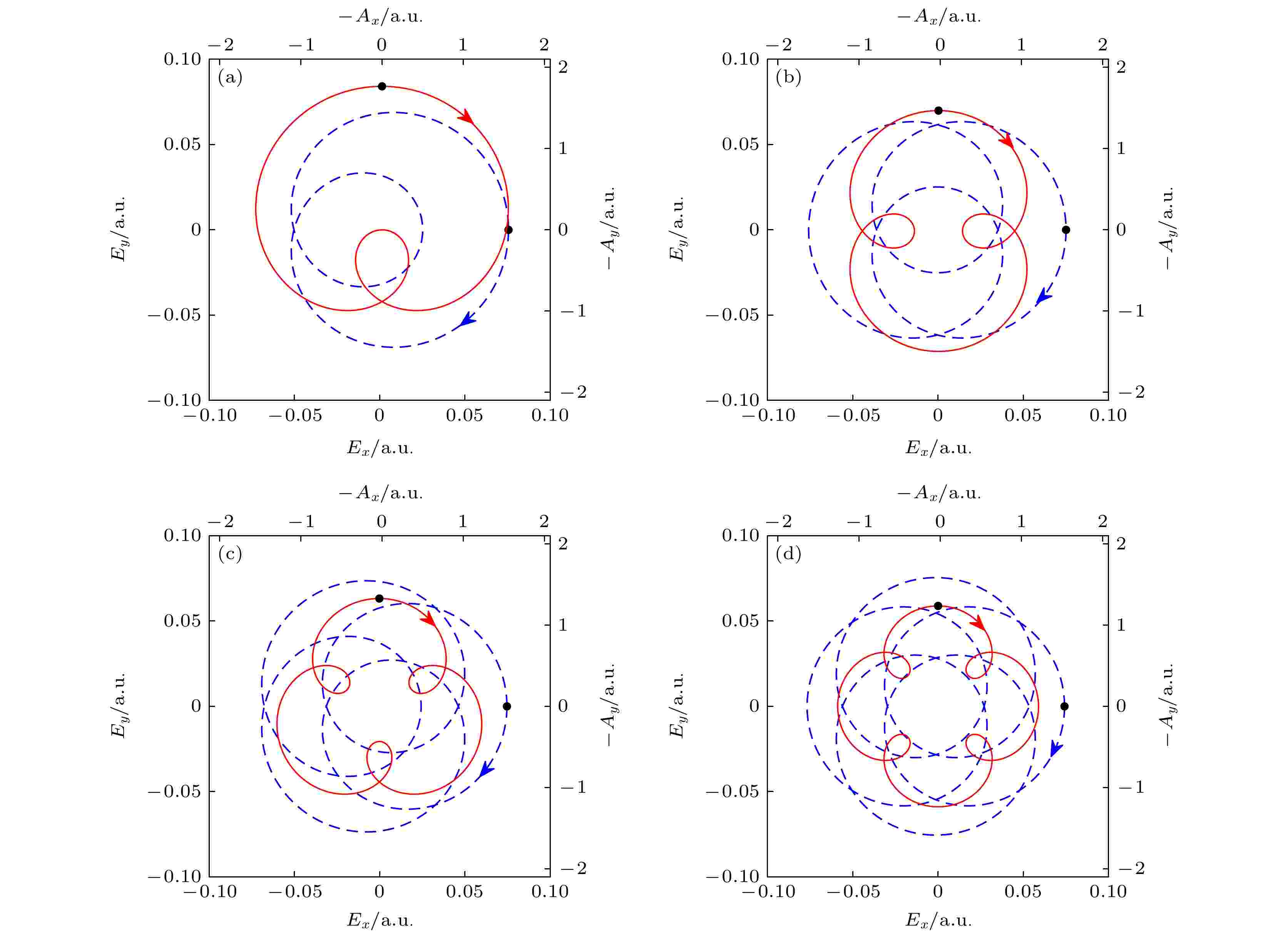
2021, 70 (24): 243201.
doi: 10.7498/aps.70.20211112
Abstract +
Using a three-dimensional classical ensemble model, we investigate ultrafast dynamics in nonsequential double-ionization (NSDI) of Ar atom by co-rotating two-color circularly polarized laser fields with the frequency ratio varying between 2 and 5. Numerical results indicate that the NSDI probability gradually increases with the frequency ratio between the two components increasing. The probability for the frequency ratio 5 is one order of magnitude higher than for the frequency ratio 2. Back analysis of NSDI trajectories shows that recollision occurs mainly via a short looping trajectory. With the frequency ratio increasing, the traveling time of the free electron shortens. Furthermore, the relative contribution of recollision-induced excitation with subsequent field ionization mechanism in NSDI gradually increases as the frequency ratio increases. It is attributed to smaller recollision energy and larger recollision distance for larger frequency ratio.
ELECTROMAGNETISM, OPTICS, ACOUSTICS, HEAT TRANSFER, CLASSICAL MECHANICS, AND FLUID DYNAMICS

2021, 70 (24): 244201.
doi: 10.7498/aps.70.20210964
Abstract +
An optical fragile watermarking method is proposed based on visual cryptography and QR code for image authentication and tamper detection. On the one hand, the original image is transformed into a QR watermark image to improve the watermark hiding capacity. On the other hand, the visual cryptography and optical phase coding are fused to encrypt the watermark image to enhance system security. The feasibility, vulnerability and imperceptibility of the proposed scheme are tested through a series of attacks and tampering. The simulation results show that the proposed method can not only have good imperceptibility, but also achieve high detection performance under different attacks and tampering.

2021, 70 (24): 244202.
doi: 10.7498/aps.70.20211138
Abstract +
Based on the thermal blooming effect theory for high-energy laser propagating in atmosphere, the vector model concept of thermal distortion parameter $ {{\boldsymbol{N}}_{\text{D}}} $ is put forward. Based on the vector model concept of thermal distortion parameter and the laser system simulation software EasyLaser, the scaling law between the centroid offset of laser beam farfield and the vector thermal distortion parameter is simulated and analyzed. The simulation results indicate that the centroid offset quantity is in direct proportion to the modulus of vector thermal distortion parameter $ {{\boldsymbol{N}}_{\text{D}}} $ , and the centroid offset direction is opposite to the direction of vector thermal distortion parameter $ {{\boldsymbol{N}}_{\text{D}}} $ . Based on the scaling law, by real-time measuring the atmosphreic parameters on laser beam propagation path, the beam deviation of laser system can be conveniently estimated in practical application.

2021, 70 (24): 244203.
doi: 10.7498/aps.70.20210562
Abstract +
A method of estimating the explosion sound source energy is proposed by combining atmospheric sound field simulation with mid- and short-range overpressure amplitude attenuation model. Aiming at the problem that the traditional sound source energy estimation formula fails to make full use of the atmospheric parameters and the estimation error is too large, through numerically simulating the propagation loss in the atmosphere, the correction effectiveness of the atmospheric parameters to the sound source energy estimation is greatly improved and the estimation accuracy of the sound source energy is enhanced. In the surface chemical explosion experiment, the infrasound is used to receive the signal from 300 km to 2500 km away. A comparison of energy estimation effectiveness between the traditional energy estimation formula and the energy estimation method based on atmospheric sound field simulation of the explosion sound source is made. The experimental results indicate that this method is effective in improving the robustness of yield estimation in comparison with the traditional yield estimation method.

2021, 70 (24): 244204.
doi: 10.7498/aps.70.20211201
Abstract +
The problem of turbulence has been puzzling relevant researchers for more than 300 years. Although some feasible solutions and models have been proposed, the turbulence still brings trouble in the foreseeable future. Turbulence is caused mainly by buoyant thermal bubbles and wind shear, which transports matter and energy between the earth surface and the atmosphere. Based on the analysis of the measured data obtained from the Sea Monsoon Experiment-II (SMEX-II), carried out on the ‘Shenkuo’ scientific research ship, the vertical spatial distribution of meteorological data overseas was explored when the air sounding balloons were released at relatively fixed times during June 2019. Through the Tatarski model, the main influencing factors of fitting turbulence profile over the sea and the turbulence evolution of boundary layer top and tropopause are discussed. Meanwhile, the effect of offshore distance of the scientific research ship on the vertical profile of optical turbulence strength is analyzed. The results show that the outer scale plays a decisive role in the distribution of turbulence over the seas. The inverse growth section between the boundary layer top and the tropopause depends on the sudden change of temperature gradient. The underlying land surface has a significant influence on the inverse growth section to the boundary layer top, while the underlying sea surface has a more pronounced influence on the inverse growth section of the tropopause. Based on the obtained data and corresponding analysis, the spatiotemporal distribution characteristics of optical turbulence overseas are grasped, which provides necessary references for selecting the astronomical observation sites, atmospheric laser transmission, and satellite remote sensing observations over the sea.

2021, 70 (24): 244301.
doi: 10.7498/aps.70.20210852
Abstract +
The method of estimating matched field power solves the problem that the traditional method of estimating power under the assumption of spherical or cylindrical wave is greatly affected by the shallow water waveguide. However, the accuracy of the matched field power estimation is seriously affected by the environmental uncertainty. In this work, the environmental sensitivity in source power estimation is defined, and the loss of the source power estimation performance is quantified when the environment is uncertain. The relation between the loss of the source power estimation performance and the estimation deviation of the acoustic transfer function is derived by using the modulus deviation and the angle between the estimated acoustic transfer function and the ideal value. On this basis, we study the mechanism of the influence of environmental uncertainty on source power estimation, and the influences of water depth, sound speed of water and sound speed of sedimentary layer on the estimation of source power. The results show that the influences of different environmental parameters on the modulus are small, and the decline of the power estimation performance is mainly due to the fact that the angle varies greatly. The change of water depth has the most significant influence on the power estimation results, and the change of sound speed of sedimentary layer exerts little influence on the power estimation results. Beside the water depth, the change of sound speed of water has a greater influence on the power estimation results at high frequencies.

2021, 70 (24): 244302.
doi: 10.7498/aps.70.20211203
Abstract +
For realizing the effective broadband insulation of sound at low frequencies, a novel local resonant acoustic metamaterial plate having quasi-zero stiffness is proposed. Based on the classical mass-spring local resonance model, a metastructure is constructed by introducing additional inclined springs with negative stiffness. First, the normalized equivalent stiffness of the quasi-zero stiffness structure is derived from the perspective of dynamics. Then, by employing the method of equivalent medium, a sound insulation model of the metastructure is established theoretically. For validation, numerical simulations as well as experimental measurements are carried out. It is demonstrated that in the positive (equivalent) stiffness regime, increasing either the stiffness ratio or pre-compression can significantly reduce the local resonance frequency of the metastructure, which exhibits the great insulation performance around the local resonance frequency. For a typical example, the proposed metastructure can achieve a transmission loss of 30 dB around 10 Hz. In contrast, within the negative stiffness regime, the metastructure does not exhibit local resonance, thus avoiding sound insulation valley caused by the “coincidence effect”. Compared with traditional materials or similar metamaterials, the proposed metastructure has significant advantages in sound insulation (e.g. more than 30 dB drop over a wide frequency band of 53-1500 Hz). By analyzing the equivalent mass density, reflection coefficient, and acoustic impedance ratio of the metastructure, the physical mechanism behind its superior insulation performance is further explored. The equivalent mass density changes from positive to negative and tends to infinity at the insulation peak. The insulation peak is attributed to a nearly perfect total reflection of sound wave caused by impedance mismatch, while the insulation valley is caused by low-frequency “coincidence effect” originating from the local resonance band gap. The using of the quasi-zero stiffness local resonance to achieve low-frequency broadband sound insulation overcomes the disadvantages of traditional metamaterials such as reduced stiffness or additional mass, thus becoming vastly attractive for constructing low-frequency broad band sound insulation structures.
2021, 70 (24): 244501.
doi: 10.7498/aps.70.20210372
Abstract +
The Mei symmetry and its corresponding conserved quantities for non-migrated Birkhoffian systems on a time scale are proposed and studied. Firstly, the dynamic equations of non-migrated Birkhoffian systems (including free Birkhoffian systems, generalized Birkhoffian systems and constrained Birkhoffian systems) on a time scale are derived based on the time-scale Pfaff-Birkhoff principle and time-scale generalized Birkhoff principle. Secondly, based on the fact that the dynamical functions in the non-migrated Birkhoff’s equations still satisfy the original equations after they have been transformed, the definitions of Mei symmetry on an arbitrary time scale are given, and the corresponding criterion equations are derived. Thirdly, Mei’s symmetry theorems for non-migrated Birkhoffian systems on a time scales are established and proved, and Mei conserved quantities of Birkhoffian systems on a time scale are obtained. The results are illustrated by three examples.
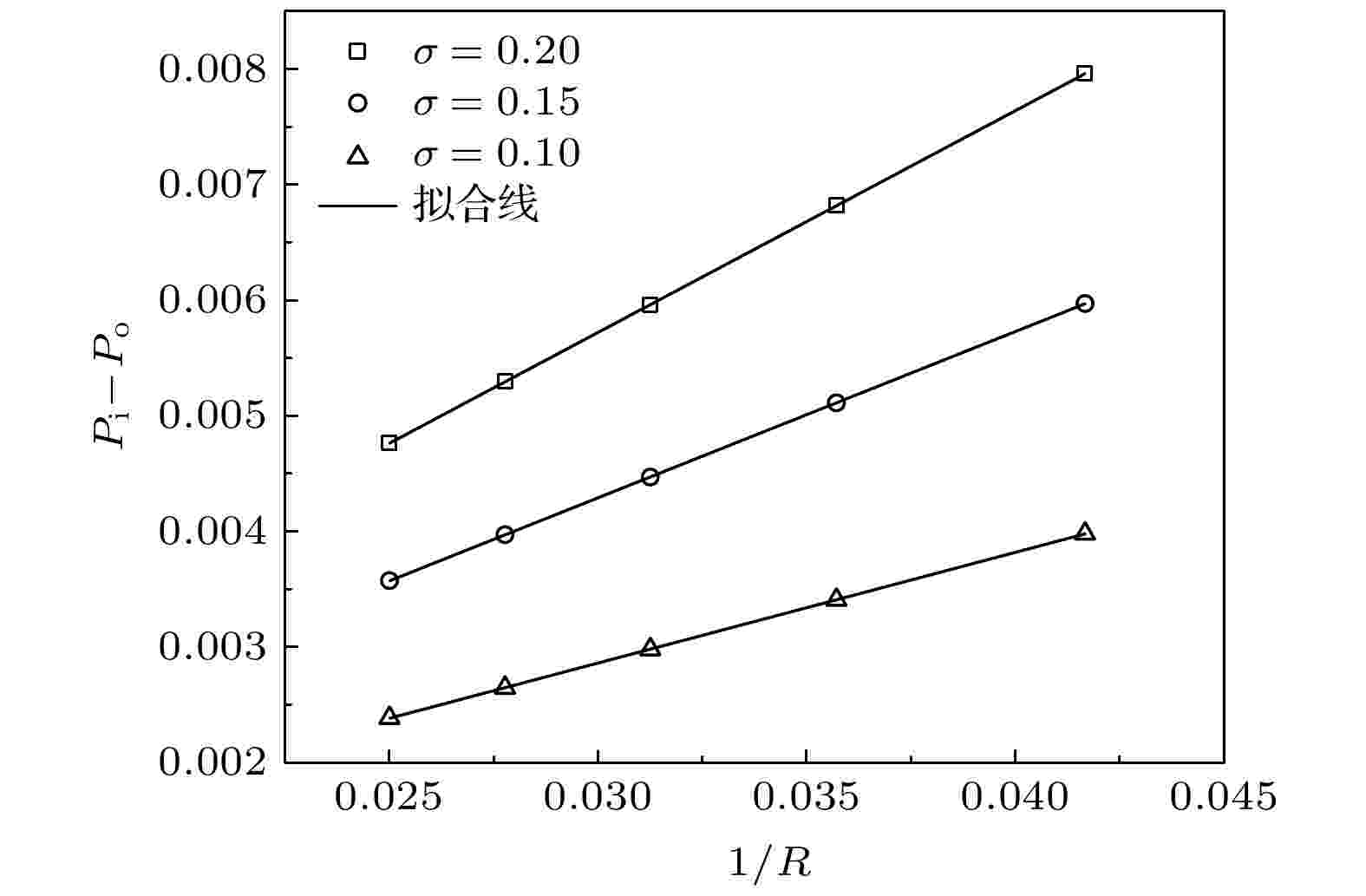
2021, 70 (24): 244701.
doi: 10.7498/aps.70.20211328
Abstract +
Bubbles are existent everywhere and of great importance for the daily life and industry process, such as heat exchange rate influenced by bubbles in the tube, battery life partially decided by bubbles of chemical reaction in it, etc. With the further requirement for miniaturization, physical mechanisms behind bubble behaviors in microchannels become crucial. In the present work, the lattice Boltzmann method is used to investigate the behavior of bubbles as they rise in complex microchannels under the action of buoyancy. The channel is placed with two asymmetric obstacles on its left and right side. Initially, the lattice Boltzmann model is tested for its reliability and accuracy by Laplace law. Then a few parameters of flow field, i.e. the Eötvös number, the viscosity ratio, the vertical distance between the obstacles, the horizontal distance between the obstacles, are employed to study the characteristics of the bubble during the movement, including the deformation, the rising speed, the residual mass, and the time of bubble passing through the channel. The results are shown below. First, the trend of the bubble's velocity changing with time in the process of passing through the channel corresponds to the change process of the dynamic behavior of the interface, i.e. the bubble velocity decreases when the bubble shape changes significantly under the same channel width. Second, with the increase of $ Eo $ number, the bubble deformation as well as the bubble velocity increases and the bubble residual mass decreases. Besides, the gas-to-liquid viscosity ratio has a significant effect on the bubble velocity. Under the condition of high viscosity ratio, the bubble shape is difficult to maintain a round shape, while the bubble rise velocity increases and the residual mass of the bubble decreases with the viscosity ratio. What is more, when the obstacle setting is changed, the longer the vertical distance between the two asymmetric obstacles, the shorter the bubble passing time is, and the faster it will return to the original shape after passing through the obstacle, while the residual mass of the bubble shows a change trend of approximately unchanged-increase-decrease-increase with the augment of the vertical distance between the obstacles. In the study of changing the horizontal spacing, two cases: the two obstacles are changed at the same time (Case A) and only the one-sided obstacle is changed (Case B), are considered. The results show that under the same small horizontal interval, the obstruction effect caused by changing only the length of one side obstacle is stronger. Finally, the study shows that when the width of the right obstacle is long enough, although the width of the obstacle continues to increase, the passing time of the bubble increases slowly, and the position of the bubble leaving from the obstacle is always approximately the same.
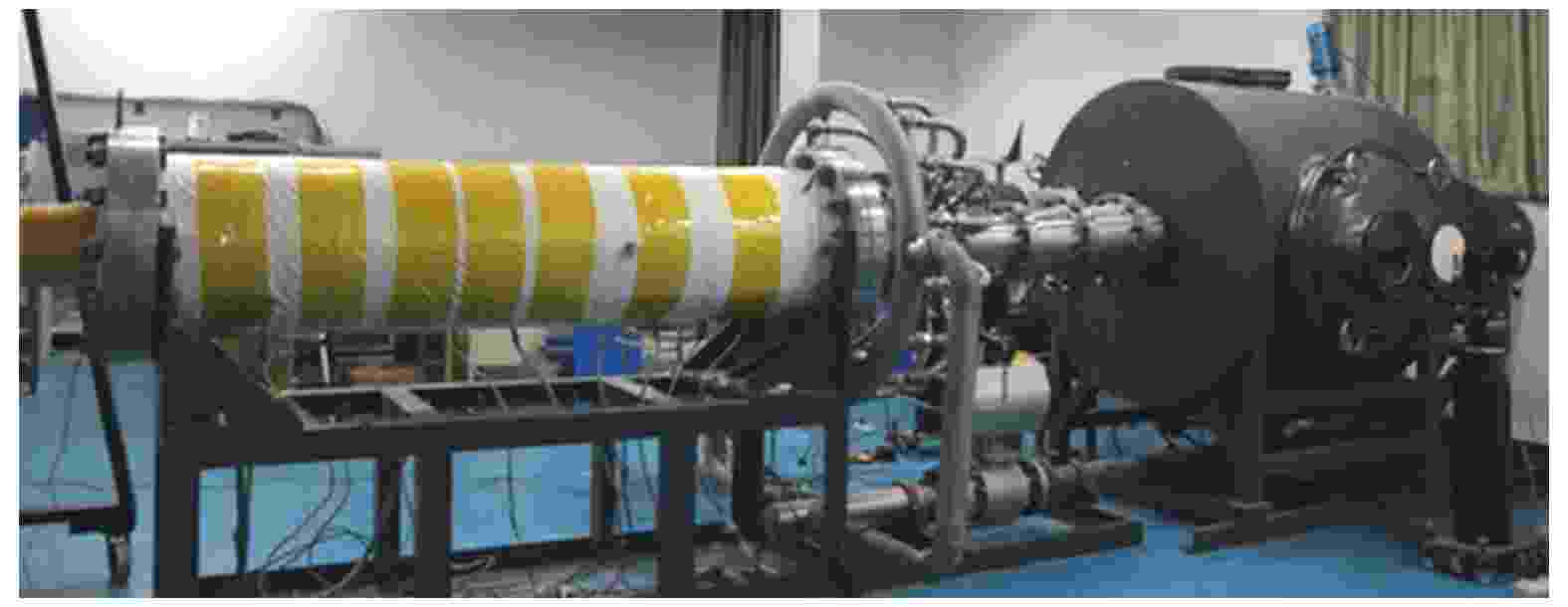
2021, 70 (24): 244702.
doi: 10.7498/aps.70.20210807
Abstract +
In this work, the cross-flow instability on the surface of a blunt elliptical cone with a long-short-axis ratio of 4∶1 is studied experimentally in the Mach 6 hypersonic quiet wind tunnel. Comprehensive use of temperature sensitive paint (TSP) technology, nano-tracer-based planar laser scattering (NPLS) technology and Kulite sensor pressure test to measure the temperature distribution in the cross-flow area on the surface of the model, boundary layer flow structure and model surface pressure are tested. The mechanism of boundary layer transition in the cross-flow control area on the surface of the elliptical cone is studied, and the influence law of incoming flow unit Reynolds number and angle of attack on boundary layer transition is obtained, and some conclusions are obtained below. In the wind tunnel noise mode, the transition of the boundary layer in the cross-flow area between the surface center line and the leading edge of the elliptical cone model with a length-to-short-axis ratio of 4∶1 is controlled by the traveling waves, and no footprint of the steady vortex is found. The characteristic frequency of the traveling wave is about 20 kHz. When the unit Reynolds number of the incoming flow increases, the transition position will be advanced, and the frequency and amplitude of the traveling wave will increase. Within a certain angle of attack, the transition position of the upwind boundary layer is delayed, and the characteristic frequency of the traveling wave does not change much but the energy is weakened. When the angle of attack continues to increase, the transition phenomenon disappears.

EDITOR'S SUGGESTION
2021, 70 (24): 244703.
doi: 10.7498/aps.70.20211386
Abstract +
When a droplet is placed on a surface with a temperature higher than Leidenfrost temperature, it will be levitated on its own vapor cushion, which makes the droplet have amazing mobility. Generally, the vapor flow under the droplet is corrected by constructing asymmetry micro/nano textured surfaces to realize the self-propulsion of the droplet. However, the control of droplet dynamics becomes uncertain due to the complicated interaction among liquid-vapor-solid phases, and the direction of droplet motion and droplet transport velocity (10-40 cm/s) have limitations. Leidenfrost heat transfer surface and impact surface are constructed in this experiment. When the surface of Leidenfrost heat transfer for droplet levitation contacts the droplet which the sufficient energy flows towards, the rough ring surface acts as an igniter. When a warm Leidenfrsot droplet (fuel) contacts skirt ring (igniter), abundant micro/nano cavities of rough skirt ring not only generate additional radiation heat flux towards droplet but also provide nucleation sites to trigger explosive boiling on a ~10 ms time scale. The thrust force Fth generated by periodic explosive boiling realizes the self-propulsion of droplets. In the initial stage of droplet motion, the inertial force Fi is dominant, and the droplet impact is mostly specular reflection, and the droplet trajectory is chaotic. With the decrease of droplet diameter, the pulsed thrust Fth is dominant, and the droplet trajectory passes through the center of the Leidenfrost heat transfer surface. Our experimental results show that the droplet passes through the center of the Leidenfrost heat transfer surface in a wide diameter range (D = 0.671-1.576 mm). For the last (150th) collision with the rough ring, the curved trajectory exists instead of line trajectory with $ D \sim 0.105 $ mm. For a very small droplet, the drag force Fd is dominant, which prevents the droplet from continuing to move. The droplet is followed by sessile droplet evaporation until it totally disappears. At the same time, the droplet transport velocity is as high as 68.91 cm/s, which has not been realized before. The present work provides a new method to manipulate droplet motion at a high temperature. Our Leidenfrost system is simple, cost-effective and lasts long-term operation because it does not depend on complicated micro/nano fabrications, which is expected to be used in microfluidic and heat transfer two-phase systems.
PHYSICS OF GASES, PLASMAS, AND ELECTRIC DISCHARGES

2021, 70 (24): 245201.
doi: 10.7498/aps.70.20211061
Abstract +
In this paper, the effects of non-Maxwellian distribution of electrons on the characteristics of magnetized plasma sheath with secondary electron emission are investigated by using a magnetic fluid model of one-dimensional velocity and three-dimensional space. The velocity of electrons follows the non-extensive distribution, and the ions are magnetized in a magnetic field with a certain tilt angle relative to the wall. The effects of the non-extensive electron distribution parameter q and the magnetic field strength and angle on the Bohm criterion, the floating wall potential, the secondary electron number density at the sheath edge, the sheath thickness and the ion velocity are studied by establishing the self-consistent equations. When the electron velocity distribution deviates from the Maxwellian distribution, the results show that as the q-parameter increases, the value of the Bohm criterion decreases, the floating wall potential increases, the number of secondary electrons at the sheath increases, the sheath thickness decreases, the number density of ions and electrons decline faster, the number density of ions near the wall is higher, and the velocities of the ions in the three directions are all reduced. In addition, as the magnetic field strength increases, the sheath thickness decreases, and the number density of ions and electrons in the sheath area decrease rapidly; the larger the magnetic field angle, the more significant the influences of the parameter q on the wall potential and the sheath thickness are, while the velocity component of the ion in the x-direction decreases with the increase of the magnetic field angle, but in the case of super-extensive distribution (q < 1), the velocity change near the wall presents an opposite trend, the increase of magnetic field angle causes wall velocity to increase; when it is close to Maxwellian distribution (q → 1), the velocity near the wall does not depend on the change of the magnetic field angle and basically tends to be identical; in the case of sub-extensive distribution (q > 1), the velocity near the wall decreases with the magnetic field angle increasing.
CONDENSED MATTER: STRUCTURAL, MECHANICAL, AND THERMAL PROPERTIES

EDITOR'S SUGGESTION
2021, 70 (24): 246301.
doi: 10.7498/aps.70.20211015
Abstract +
Based on the first-principles calculations, the stability, elastic constants, electronic structure, and lattice thermal conductivity of monolayer XO2 (X = Ni, Pd, Pt) are investigated in this work. The results show that XO2 (X = Ni, Pd, Pt) have mechanical and dynamic stability at the same time. In addition, the Young’s modulus of monolayer NiO2, PdO2 and PtO2 are 124.69 N·m–1, 103.31 N·m–1 and 116.51 N·m–1, Poisson’s ratio of monolayer NiO2, PdO2 and PtO2 are 0.25, 0.24 and 0.27, respectively, and each of them possesses high isotropy. The band structures show that monolayer XO2 (X = Ni, Pd, Pt) are indirect band-gap semiconductors with energy gap of 2.95 eV, 3.00 eV and 3.34 eV, respectively, and the energy levels near the valence band maximum and conduction band minimum are mainly composed of Ni-3d/Pd-4d/Pt-5d and O-2p orbital electrons. Based on deformation potential theory, the carrier mobility of each monolayer is calculated, and the results show that the effective mass and deformation potential of monolayer XO2 (X = Ni, Pd, Pt) along the armchair and zigzag directions show obvious anisotropy, and the highest electron and hole mobility are 13707.96 and 53.25 cm2·V–1·s–1, 1288.12 and 19.18 cm2·V–1·s–1, and 404.71 and 270.60 cm2·V–1·s–1 for NiO2, PdO2 and PtO2, respectively. Furthermore, the lattice thermal conductivity of monolayer XO2 (X = Ni, Pd, Pt) at 300 K are 53.55 W·m–1·K–1, 19.06 W·m–1·K–1 and 17.43 W·m–1·K–1, respectively. These properties indicate that monolayer XO2 (X = Ni, Pd, Pt) have potential applications in nanometer electronic materials and thermal conductivity devices.
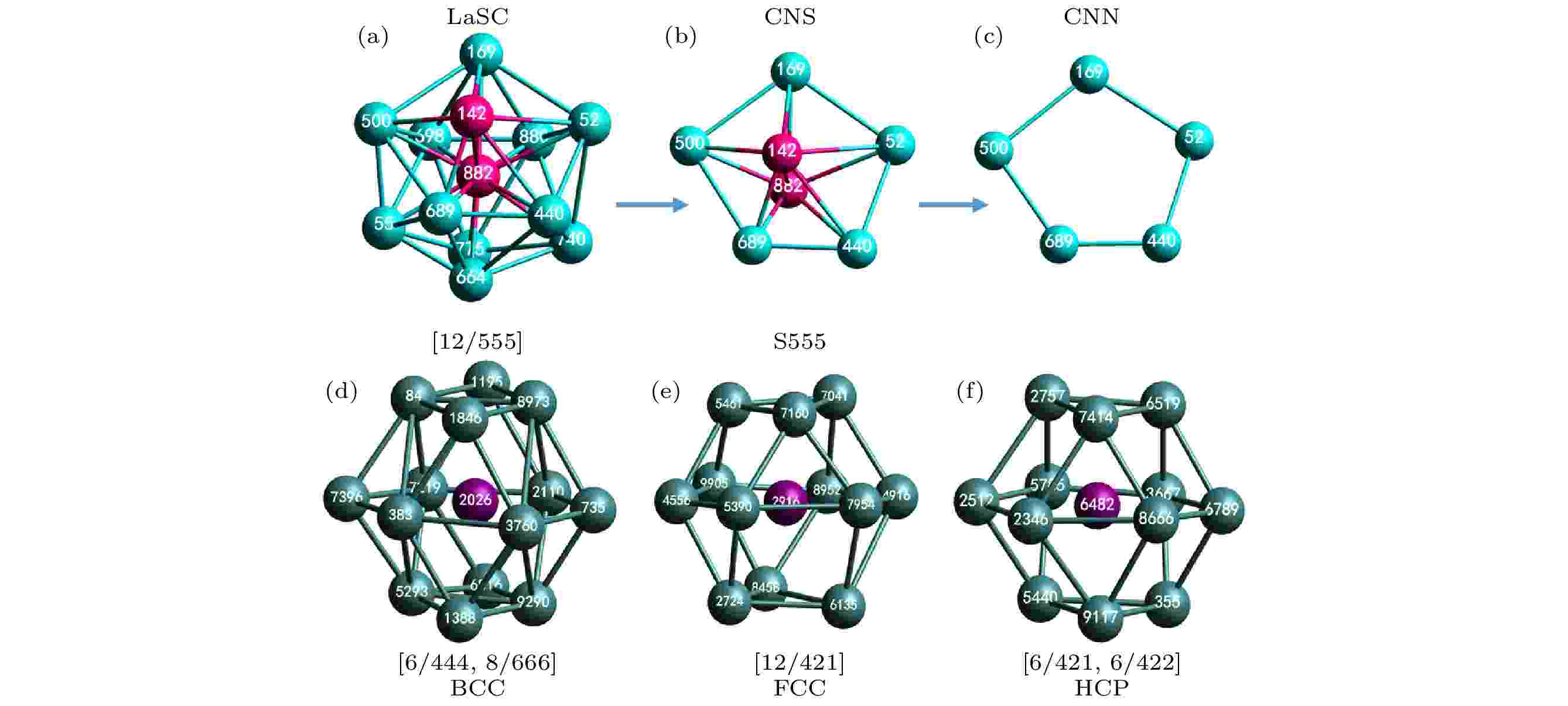
2021, 70 (24): 246401.
doi: 10.7498/aps.70.20211235
Abstract +
It is difficult to obtain bulk amorphous alloys experimentally due to the limitation of cooling technology and the ability to form amorphous alloy. However, the rapid cooling of nano-droplets is relatively easy, so the simulation research of nano-droplets is easier to verify experimentally. In this work, the molecular dynamics simulation for the rapid cooling of Cu64Zr36 nano-droplets of different sizes is conducted at a cooling rate of 1.0 × 1012 K/s, and the evolution of microstructure is analyzed in terms of the average potential energy, the pair distribution function, the three-dimensional visualization, and the largest standard cluster analysis. The analysis of the energy curves and the characteristic length for short-range-ordered microstructure show that the solidification process for all nano-droplets undergoes liquid-liquid transition and liquid-solid transition, and finally forms amorphous nanoparticles. Comparing with the icosahedron, the evolution of the topologically close-packed (TCP) structures can reflect the basic characteristics of phase transitions effectively. Based on the evolution of TCP clusters, the entire solidification process of nano-droplets can be divided into four stages: embryo, aggregation, growth and coarsening. The TCP structure embodies the basic structural characteristics of amorphous nano-droplets and particles, which is of great significance in perfecting the solidification theory.
CONDENSED MATTER: ELECTRONIC STRUCTURE, ELECTRICAL, MAGNETIC, AND OPTICAL PROPERTIES

EDITOR'S SUGGESTION
2021, 70 (24): 247101.
doi: 10.7498/aps.70.20210697
Abstract +
Frame et al. (Frame D, He R Z, Ipsen I, Lee D, Lee D, Rrapaj E 2018 Phys. Rev. Lett. 121 032501 ) proposed to use eigenvector continuation to solve high-dimensional many-body wavefunctions of relevant quantum models. When a model’s Hamiltonian matrix includes smoothly varying parameters, the corresponding eigenvector trajectory spans only a low-dimensional subspace. Therefore, it is possible to simplify the calculations by projecting the Hamiltonian onto a set of basis vectors of this subspace. However, the dimension of the trajectory subspace and its relationship with the size of the model are still unclear. In this paper, we study the antiferromagnetic Heisenberg chain models of different sizes systematically; their exchange interactions change with parameters smoothly. We first use principal component analysis to determine the subspaces of ground state many-body wavefunction vector trajectories of a 4-spin model and a 6-spin model, and plot the trajectories in the subspaces, respectively; we then analyze the principal components of ground state vector trajectories of models including $8,\cdots ,14$ spins, and reveal that when using eigenvector continuation to solve the ground state of an antiferromagnetic Heisenberg chain model, the number of basis vectors required increases with the number of spins in the model increasing. Our study can guide the application of eigenvector continuation in solving the Hamiltonian of a Heisenberg chain model containing more spins.

EDITOR'S SUGGESTION
2021, 70 (24): 247401.
doi: 10.7498/aps.70.20210936
Abstract +
The CrBr3 monolayer is a two-dimensional semiconductor material with intrinsic ferromagnetism. However, the low Curie temperature of CrBr3 monolayer limits its practical development in innovative spintronic devices. The electronic and magnetic properties of transition-metal atoms doped CrBr3 monolayer have been systematically investigated by using the density functional theory calculations. The formation energy elucidates that all 3d transition metal (TM) atoms prefer to be doped in the middle of a hexagon (H) site of CrBr3 monolayer. And all the TM atoms, except the Zn atom, can bond strongly to the surrounding Cr atoms with sizable formation energy. The results also indicate that the magnetic moment of TM-CrBr3 system changes as a result of the charge transfer between TM atom and adjacent Cr atom. In addition, comparing with the intrinsic CrBr3, the TC of TM-CrBr3 system increases significantly, which means that the ferromagnetic stability of CrBr3 monolayer is enhanced. In particular, the TC of CrBr3 with Sc atom can be increased by 159%. The enhancement of ferromagnetism is mainly due to the competition between the direct exchange and the superexchange interaction. We also find that the electronic properties of the TM-CrBr3 systems are diverse. For example, Sc-, Ti-, V-, Mn-, Fe-, Co-, Ni-, Cu- and Zn-CrBr3 exhibit spin gapless semiconductor (SGS) properties with 100% spin polarization at Fermi level. The TM-CrBr3 system can be adjusted from semiconductor to half-metal when Cr atoms are doped into the CrBr3 monolayer. This work, together with recent achievements in the field of two-dimensional ferromagnetic materials, provides an experimentally achievable guide for realizing the preparation of TM-CrBr3 system with high Curie temperature. Moreover, the possibility of application of these systems in nanoelectronics and spintronics is increased.
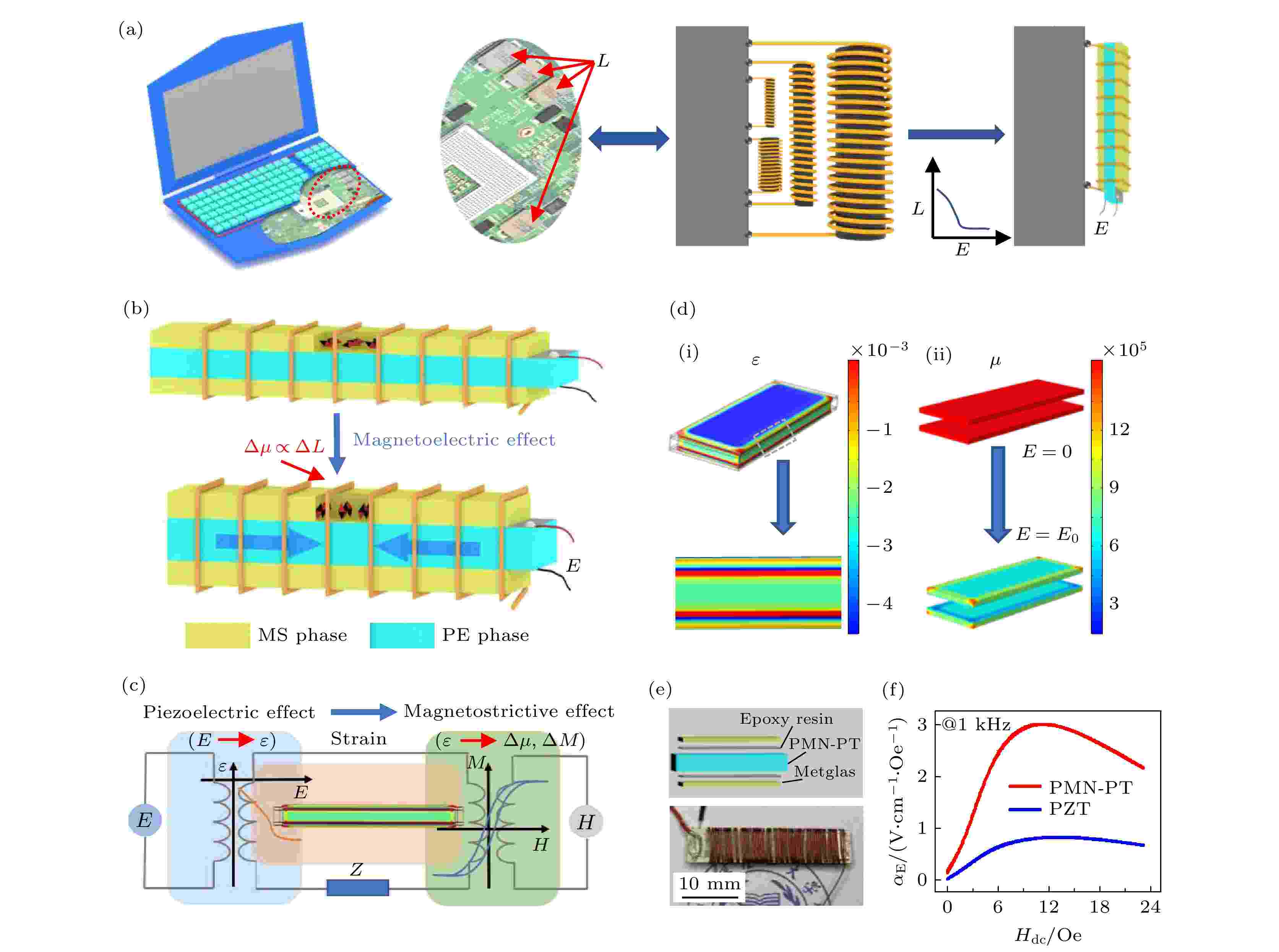
2021, 70 (24): 247501.
doi: 10.7498/aps.70.20210899
Abstract +
Magnetoelectric voltage tunable inductor (ME-VTI) realizes the modulation of electric field to inductance based on magnetoelectric effect. Compared with other adjustable inductors, it has the advantages of low energy consumption, small volume, large tunability and continuity. However, previous reports on ME-VTI mainly focused on structure and magnetostrictive materials, resulting in the complexity of inductor structure and slight improvement of tunability. This study focuses on the influence of field-induced strain in piezoelectric materials on inductance tunability by constructing a theoretical model. The magnetoelectric laminate of Metglas/ PMN-PT single crystal /Metglas is employed as a magnetic core to design ME-VTI. The tunability is as high as 680% at 1 kHz, which is over 2.4 times larger than that of the Metglas/PZT/Metglas magnetic core. The quality factor of the PMN-PT based ME laminate reaches 15.6, which is 2.8 times higher than that of the PZT-based one. The proposed PMN-PT based ME-VTI provides an alternative approach for developing the integrated and miniaturized devices, and has an important prospect of application in the field of power electronics.

2021, 70 (24): 247502.
doi: 10.7498/aps.70.20210952
Abstract +
Directional textured dysprosium foils are fabricated by rapid solidification and sequential cold rolling, and the influences of their thickness values and magnetic structures on magnetic properties are analyzed and studied. The results show that magnetic properties of cold-rolled dysprosium foils are better than those of rapid solidification dysprosium foils, and the magnetization and permeability for each of the cold-rolled dysprosium foils are related to the thickness and temperature. Below Curie temperature, the cold-rolled dysprosium foils have obvious soft magnetic properties in a temperature range from 77 K to 4.2 K, the saturation magnetization for each of cold-rolled dysprosium foils increases by 5%-8%, and the saturation magnetization of 0.15-mm-thick cold-rolled dysprosium foil arrives at 2880 kA/m at 4.2 K, and the maximum permeability of cold-rolled 0.10-mm-thick dysprosium foil approaches to 30. The cryogenic magnetization of cold-rolled dysprosium foil with a strong external magnetic field is higher than that of conventional Co-V-Fe below 85 K. The cryogenic magnetic properties of textured dysprosium foils are related to the oxygen content and the orientation degree of (0001) crystal plane. The present study lays the foundation of technology and principle for preparing the chunky directional textured dysprosium soft magnet for cryogenic undulator.

EDITOR'S SUGGESTION
2021, 70 (24): 247801.
doi: 10.7498/aps.70.20211024
Abstract +
Low-dimensional metal halides have attracted extensive attention due to their excellent optical properties, especially zero-dimensional metal halides, which can improve the radiation recombination probability due to the characteristics of their isolated octahedral structures. In this paper, we report a zero-dimensional metal halide Sb3+ doped Rb7Bi3Cl16 with a broadband orange-yellow emission at 613 nm. When the Sb3+ doping concentration is 30%, the highest photoluminescence quantum yield of the system reaches 30.7%. This high-efficiency luminescence is derived from the self-trapped excitons generated by the strong interaction between electrons and the crystal lattice. The specific physical mechanism and energy transfer process of self-trapped exciton luminescence are further studied through characterizing the optical performances. The electronic states in the singlet 1P1 level are relaxed to the triplet 3P1 via an intersystem crossing process, and the strong orange-yellow emission comes from the triplet state 3P1→1S0 radiation recombination process. In addition, Sb3+ doped Rb7Bi3Cl16 has satisfactory environmental stability, the Sb3+:Rb7Bi3Cl16-based light-emitting diodes (LED) are fabricated here in this work, and the color coordinates and correlated color temperature of the LED are (0.4886, 0.4534) and 2641 K, respectively. The highly efficient and stable Sb3+ doped Rb7Bi3Cl16 is expected to be used in solid-state lighting and display fields.
GEOPHYSICS, ASTRONOMY, AND ASTROPHYSICS

2021, 70 (24): 249201.
doi: 10.7498/aps.70.20210825
Abstract +
Based on the global surface temperature data, the global temperature correlation networks corresponding to El Niño and La Niña events are constructed respectively, and the differences in their effects on the network topological structure properties are analyzed. The results show that compared with the La Niña temperature network, the correlation between grid temperature series in El Niño temperature network is weakened, and the connectivity of the network is significantly reduced, especially in the tropical region and the southern temperate region. The network connectivity degree of equatorial eastern Pacific, equatorial western Pacific, equatorial Indian Ocean and equatorial Atlantic Ocean are relatively large, and the decrease in El Niño network is notable. They are also the four key regions leading to the differences of the structural characteristics of the two types of network. On this basis, the reason for the difference between the two types of network characteristics is preliminarily discussed. With the increase of SST in Niño3.4 region, the SST in equatorial eastern Pacific, equatorial Indian Ocean and other areas rise, which strengthenes outgoing long wave radiation and convection activities, and the interaction between low latitude and mid-latitude areas, and the variance of air temperature changes in the north and south temperate regions increase. As a result, the correlation between the temperature series of the four key regions and the rest of the world is weakened, therefore the connectivity of the global grid temperature network is reduced.















